Fire Rated Roof Underlayment: Code Compliance Guide

If you’re managing a roofing project—whether for a home in a fire-prone area or a commercial property undergoing an upgrade—you’ve likely come across the term fire rated roof underlayment. But what exactly does it mean, and when is it required by code?
This article breaks down what fire-rated underlayment is, why it matters for safety and compliance, and how to know if your building or project falls under the regulations.
Whether you’re planning a new build or retrofitting an older structure, you’ll learn which materials meet fire standards, what the codes say, and how to ask the right questions to stay protected and compliant.
Here’s what we’ll cover:
- What Is Fire-Rated Roof Underlayment?
- Why Fire-Rating Matters: Code, Safety, and Risk
- When and Where Fire-Rated Underlayment Is Required
- Types of Fire-Rated Underlayment Materials
- What to Ask Your Contractor About Fire-Rated Roofing
First, let’s understand what fire-rated roof underlayment actually is—and how it works beneath the surface to keep your property safe.
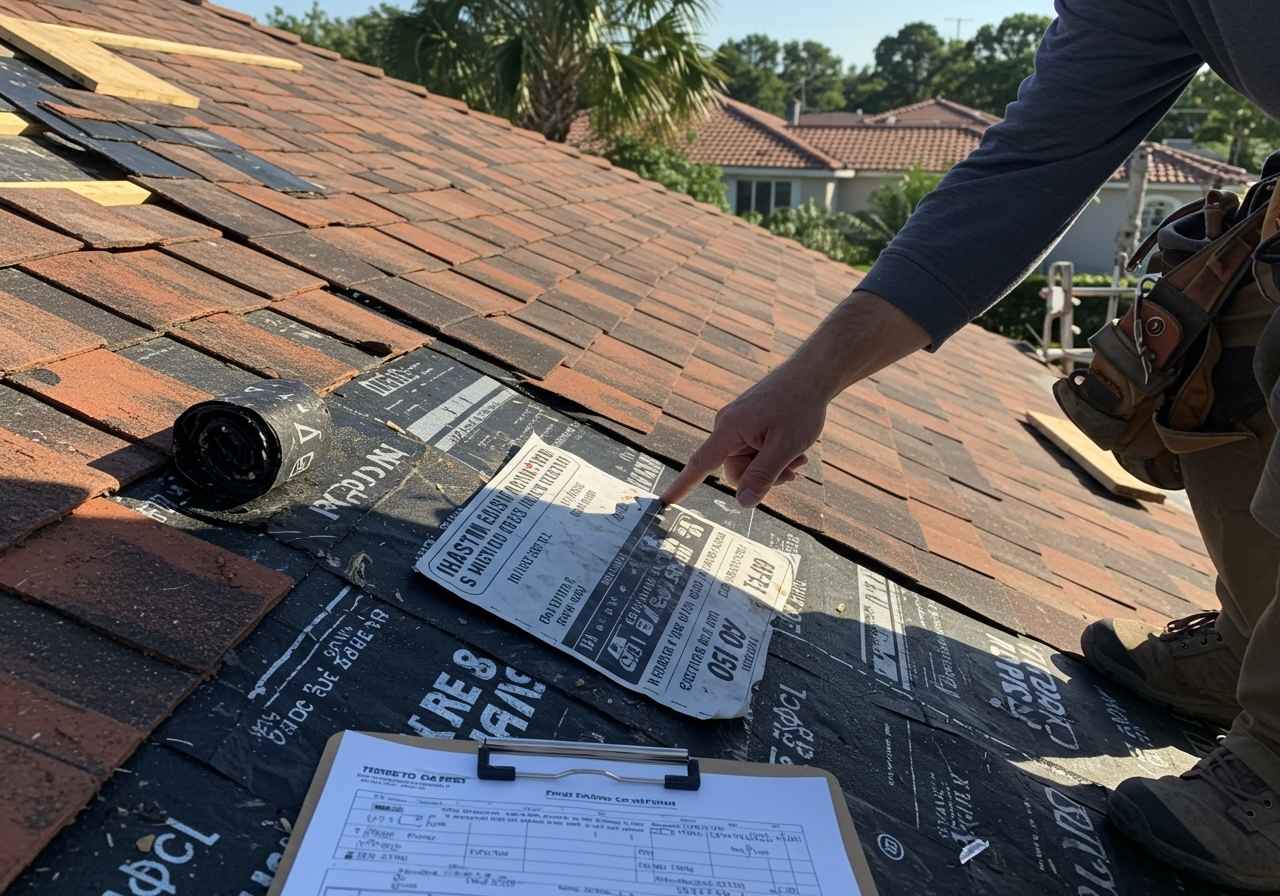
What Is Fire-Rated Roof Underlayment?
Fire rated roofing underlayment is a specialized barrier installed beneath roofing materials—like shingles, tiles, or metal panels—that’s designed to resist ignition and slow the spread of flames in the event of a fire. Unlike standard underlayment, which primarily serves as moisture protection, fire-rated versions are engineered to meet specific combustibility standards set by building codes and fire safety authorities.
What sets fire-rated underlayment apart is its ability to contribute to the overall fire classification of a roof system. For example, to achieve a Class A roof system rating—the highest level of fire resistance—a roof assembly must pass rigorous fire testing protocols (such as ASTM E108 or UL 790).
These tests evaluate how the entire system, including the underlayment, performs when exposed to direct flames and radiant heat. A compliant fire-rated underlayment helps ensure the full roof meets these standards.
You can learn more about these requirements in this comprehensive guide to ASTM Class A fire rating.
Here’s how fire-rated underlayment differs from standard materials:
- Flame-Resistant Composition: Often includes fiberglass or other non-combustible fibers that resist ignition under high temperatures.
- Ignition Barrier Functionality: Acts as a secondary fire retardant roof barrier if roofing materials are compromised.
- Tested to Code: Must meet fire-performance benchmarks like flame spread rating and resistance to burn-through.
- Required for Certain Zones: In wildfire-prone areas (such as Wildland-Urban Interface or WUI zones), building codes often mandate the use of fire-rated materials—especially under wood shake, tile, or metal roofs.
For example, if you’re installing a new tile roof on a home in Florida’s high-risk fire zone, using a standard synthetic underlayment may not meet local code compliance—but a Class A-rated fire-resistant version could satisfy both safety standards and inspection requirements.
Takeaway: Fire-rated roof underlayment isn’t just a premium option—it’s often a code-driven requirement that plays a critical role in protecting your property and achieving a Class A roof system rating.
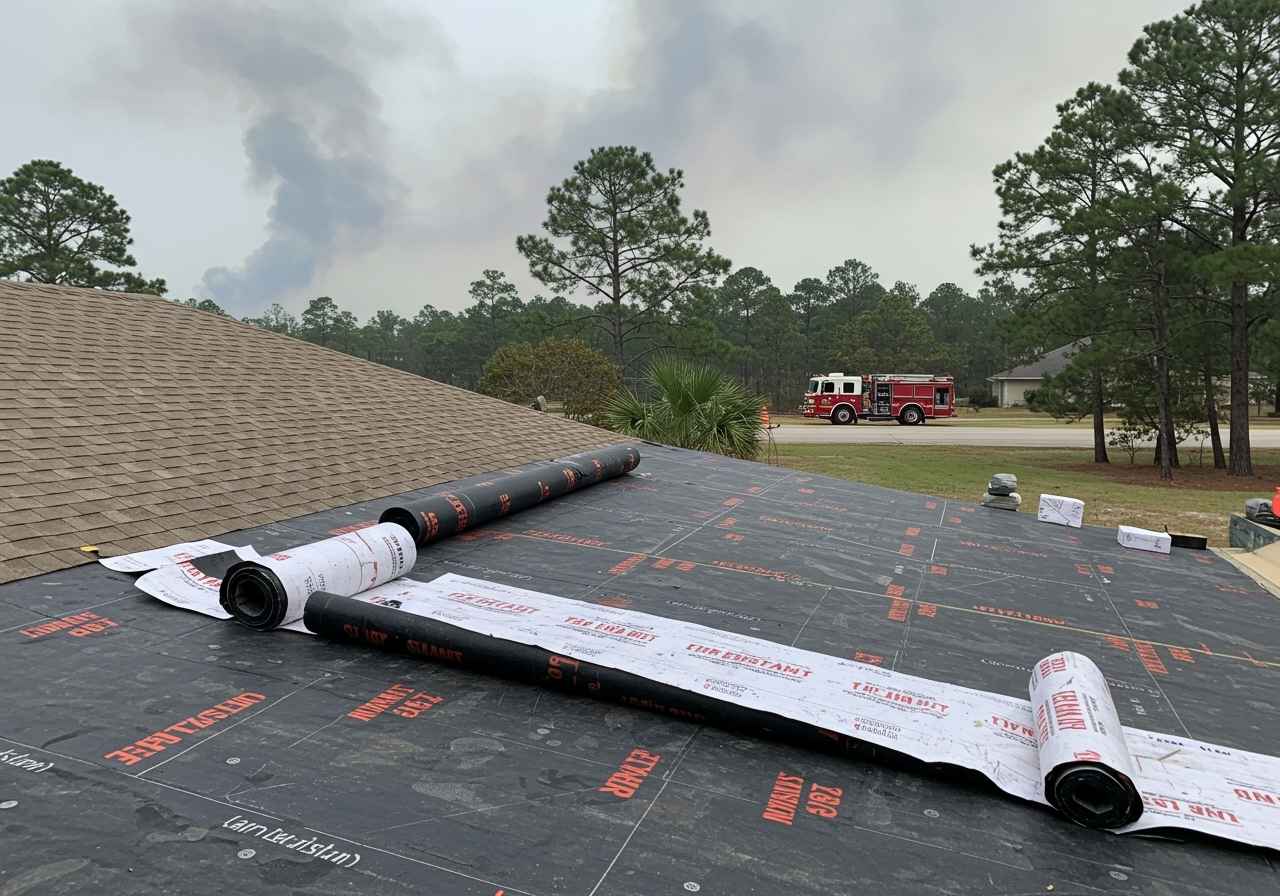
Why Fire-Rating Matters: Code, Safety, and Risk
When it comes to roofing, fire resistance isn’t just a nice-to-have feature—it’s a critical line of defense that protects buildings, occupants, and long-term investments. Fire-rated roof underlayment plays a key role in that defense by slowing ignition and reducing the spread of flames, giving emergency responders more time to act and helping to minimize structural damage.
Why This Matters for Safety
Fire-rated materials are engineered to resist ignition, reduce flame spread, and maintain structural integrity under extreme heat. In practical terms, this means that if embers land on your roof—whether from a nearby wildfire, a lightning strike, or a rooftop electrical fault—the underlayment adds a layer of protection beneath your surface material.
This is especially important in high-risk areas like Wildland-Urban Interface (WUI) zones, where windblown embers can travel miles ahead of an active fire. In these environments, even a fire-resistant roofing shingle can be compromised if it’s not paired with a compliant, tested underlayment system.
For more insight into wildfire zone construction and ignition-resistant standards, check out the International Wildland-Urban Interface Code.
The Role of Fire Ratings in Building Codes
Building codes—like the International Building Code (IBC) and standards from the National Fire Protection Association (NFPA)—require that roofing assemblies meet specific fire-resistance classifications:
- Class A: Highest level of protection; effective against severe fire exposure.
- Class B: Moderate fire resistance.
- Class C: Minimal protection; suitable only in low-risk environments.
o qualify as Class A, a roof system must include a Class A fire rated roof underlayment and pass stringent fire tests such as ASTM E108 or UL 790, which assess:
- Flame spread rating: How far flames travel across the surface.
- Ignition resistance: Whether the material catches fire from direct flame exposure.
- Burn-through protection: How long the underlayment delays fire penetration into the roof deck.
Impact on Insurance, Liability, and Property Value
Fire-rated roofing materials often result in lower insurance premiums and can be a prerequisite for coverage in fire-sensitive regions. For commercial property managers, this also translates into lower liability risks and greater peace of mind—especially for multi-tenant or publicly occupied buildings.
See these commercial roofing fire safety tips for more ways to protect your property and meet safety standards.
Failing to install compliant materials may not just result in failed inspections—it can also void warranties, compromise insurance claims, and increase exposure to legal liability if a fire occurs.
Takeaway: Fire-rated roof underlayment isn’t just about checking boxes for compliance—it’s a smart, proactive safeguard that protects lives, property, and financial interests in the face of growing fire risks.
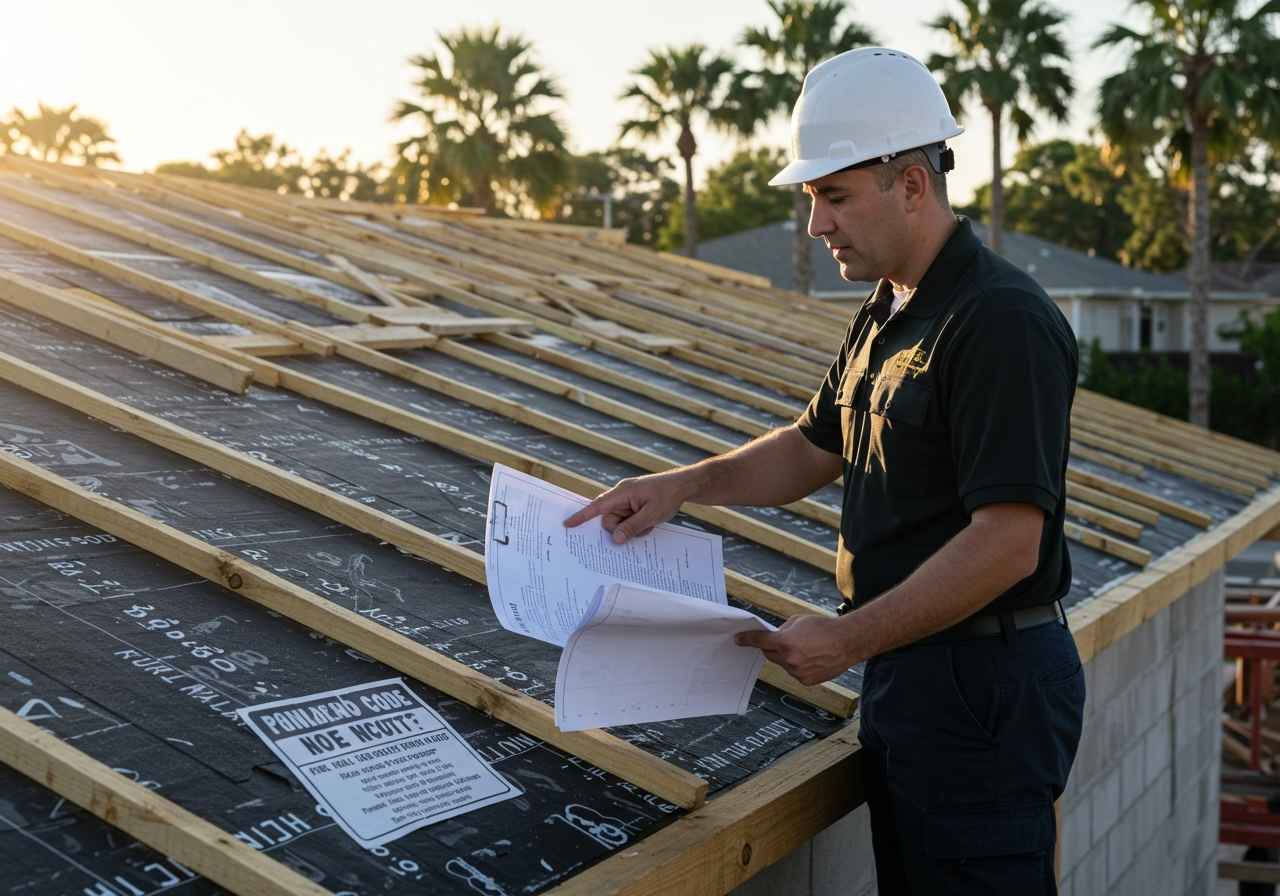
When and Where Fire-Rated Underlayment Is Required
Fire-rated roof underlayment isn’t a universal requirement—but in many areas, it’s mandated by building codes to reduce fire risk, especially in regions where wildfire or urban fire exposure is high. Knowing when and where this material is required can save you time, money, and future compliance issues—whether you’re managing a commercial property upgrade or replacing a roof on a family home.
Code Triggers That Mandate Fire-Rated Underlayment
Several regulatory frameworks govern when fire-rated materials must be used:
- International Building Code (IBC):
The IBC sets national baseline standards that are widely adopted and adapted by state and local jurisdictions. For roofing, the IBC requires fire-rated assemblies—especially Class A systems—on structures in fire hazard areas or those with combustible roof decks. - Wildland-Urban Interface (WUI) Regulations:
WUI zones are areas where structures and vegetation meet, creating increased wildfire risk. In states like California, Colorado, and parts of Florida, WUI codes require fire-rated underlayment under certain roof coverings (e.g., wood shakes or tiles) as part of a broader ignition-resistant construction mandate. - Local Code Enforcement in High-Risk Zones:
Local municipalities often adopt stricter regulations than national codes based on regional fire history and environmental risks. For example:- In parts of Southern California, underlayment for metal roofs is required to meet local fire safety codes.
- In Florida, specific counties may mandate fire-resistant roofing systems in coastal and inland zones prone to brush fires.
- In parts of Southern California, underlayment for metal roofs is required to meet local fire safety codes.
Residential vs. Commercial Requirements
- Residential Properties:
Requirements often depend on roof type, location, and proximity to wildfire zones. Homes with tile or shake roofing in high-risk zones typically must include fire-rated underlayment to achieve a Class A system. This is particularly relevant during residential roof replacement projects. - Commercial and Multi-Family Properties:
Commercial codes are generally stricter, especially for multi-tenant buildings. Fire-rated underlayment is commonly required for code compliance, insurance approval, and to meet occupancy safety standards—particularly in large-scale housing, retail centers, and mixed-use developments.
New Builds vs. Retrofits
- New Builds:
Must meet the most current code standards. Fire-rated underlayment is often required from the outset, especially in jurisdictions aligned with updated IBC or WUI provisions. - Retrofits and Re-Roofs:
These projects typically trigger code upgrades if 25% or more of the roof is being replaced. In many jurisdictions, that means switching to a compliant fire-rated system, regardless of what was previously installed.
Scenario: “Do I Need This in a Florida Multi-Family Property?”
Yes—if your property is located in or near a WUI-designated zone or local ordinance area that mandates enhanced fire protection. Multi-family dwellings often fall under stricter commercial code enforcement. For example, if you’re replacing a tile or metal roof in a Central Florida complex near wooded areas, you may need a Class A roof system, including certified fire-rated underlayment.
Takeaway: Whether you’re building new or replacing an existing roof, code compliance for fire-rated underlayment depends on your location, roof type, and building use. Don’t assume past materials still meet current standards—check with local authorities or your contractor to be sure.
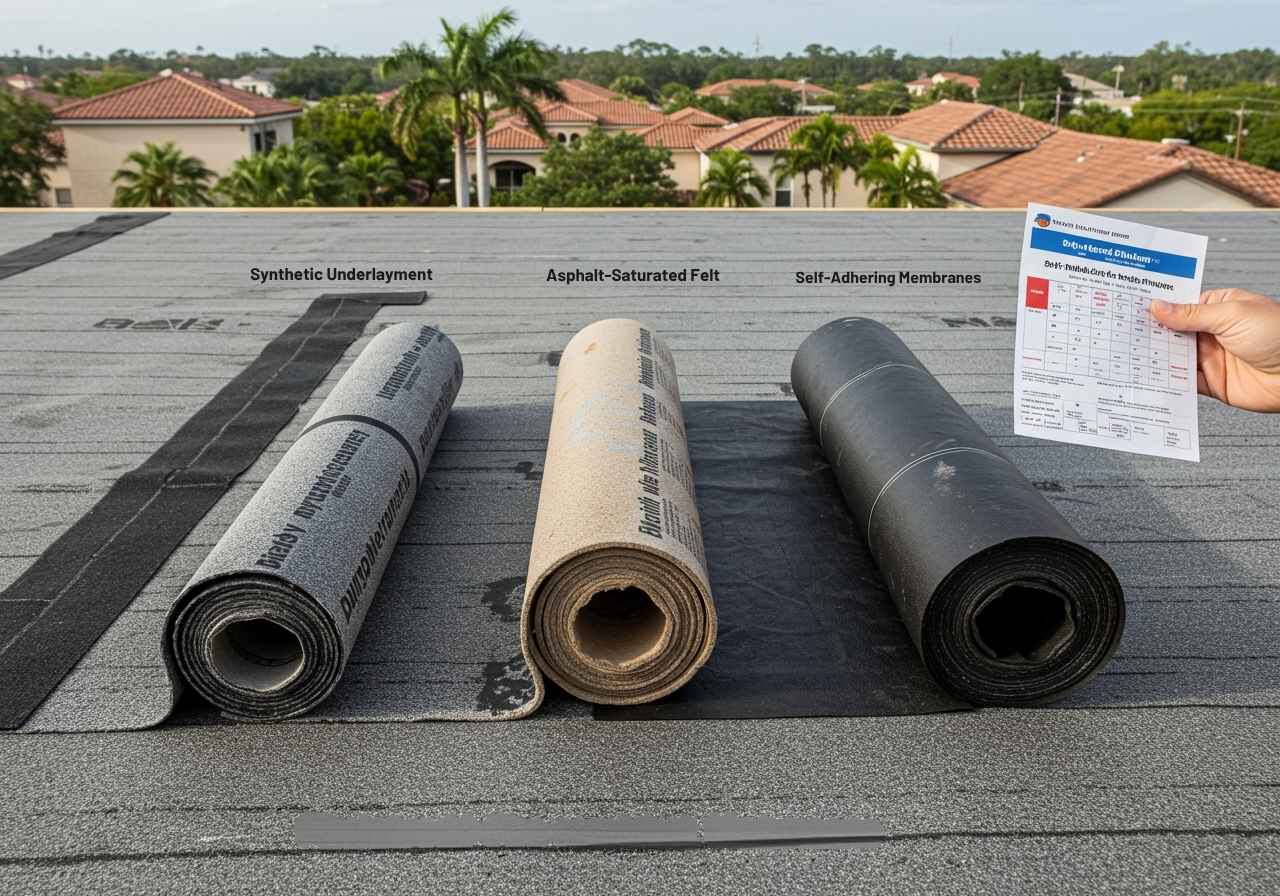
Types of Fire-Rated Underlayment Materials
Not all underlayments are created equal—and when fire resistance is a priority, choosing the right type is critical to meeting building codes and protecting your investment. If you’re unsure which option is right for your project, this roof underlayment selection guide provides a helpful breakdown of materials and their advantages.
Fire-rated underlayment materials come in several varieties, each with unique performance characteristics, installation requirements, and code implications.
Here’s a breakdown of the most commonly used fire-resistant underlayments and how they compare:
1. Synthetic Underlayment (Fire-Rated Versions)
- What It Is: A lightweight, durable material made of woven or spun polymer, often reinforced with fiberglass for enhanced fire resistance.
- Benefits:
- High tear strength and UV resistance
- Lightweight and easy to install
- Fire-rated models meet ASTM E108 and UL 790 standards
- High tear strength and UV resistance
- Best For: Steep-slope roofing, tile or metal roofs in wildfire-prone areas
Note: Not all synthetic underlayments are fire-rated—make sure the product is explicitly certified for use in Class A systems.
2. Asphalt-Saturated Felt (Enhanced or Fire-Treated)
- What It Is: A traditional option in the comparison between felt and synthetic underlayment, this material is made of cellulose or fiberglass mat soaked in asphalt; fire-rated versions include fire-retardant additives.
- Benefits:
- Cost-effective
- Provides decent flame resistance when paired with Class A shingles
- Cost-effective
- Limitations:
- Less durable under prolonged heat or UV exposure
- Heavier and more labor-intensive than synthetic options
- Less durable under prolonged heat or UV exposure
- Best For: Residential retrofits where budget constraints exist but code compliance is necessary
3. Peel-and-Stick or Self-Adhering Membranes
- What It Is: A self-bonding membrane that adheres directly to the roof deck, often with rubberized asphalt or modified bitumen.
- Benefits:
- Excellent fire resistance and waterproofing
- Creates a sealed, ignition-resistant layer
- Ideal for complex roof geometries or low-slope areas
- Excellent fire resistance and waterproofing
- Best For: Commercial buildings or retrofits requiring high fire and water protection; coastal or high-exposure zones
4. Fire-Rated Sheathing or Vapor Barrier Combinations
- What It Is: Additional fire-resistant sheathing layers or integrated vapor/fire barriers installed under the underlayment.
- Benefits:
- Adds redundancy in ignition resistance
- Enhances performance in high-humidity, high-heat regions
- Adds redundancy in ignition resistance
- Best For: Multi-family, mixed-use, or industrial facilities requiring layered protection strategies
Matching Material to Roof Slope and Code
- Steep-Slope Roofs (e.g., shingle, tile, metal): Fire-rated synthetic or peel-and-stick options are often preferred.
- Low-Slope or Flat Roofs: Require specialized membranes—check both fire and water-resistance ratings.
- Retrofits vs. New Builds: Retrofitting may favor peel and stick underlayment for ease of installation and added protection; new builds offer more flexibility for integrated systems.
Takeaway: Choosing the right roofing underlayment with fire resistance means balancing material performance, slope compatibility, and code compliance. Confirm that the product you select is tested and certified for fire resistance—and suited to the specific needs of your roof type and location.
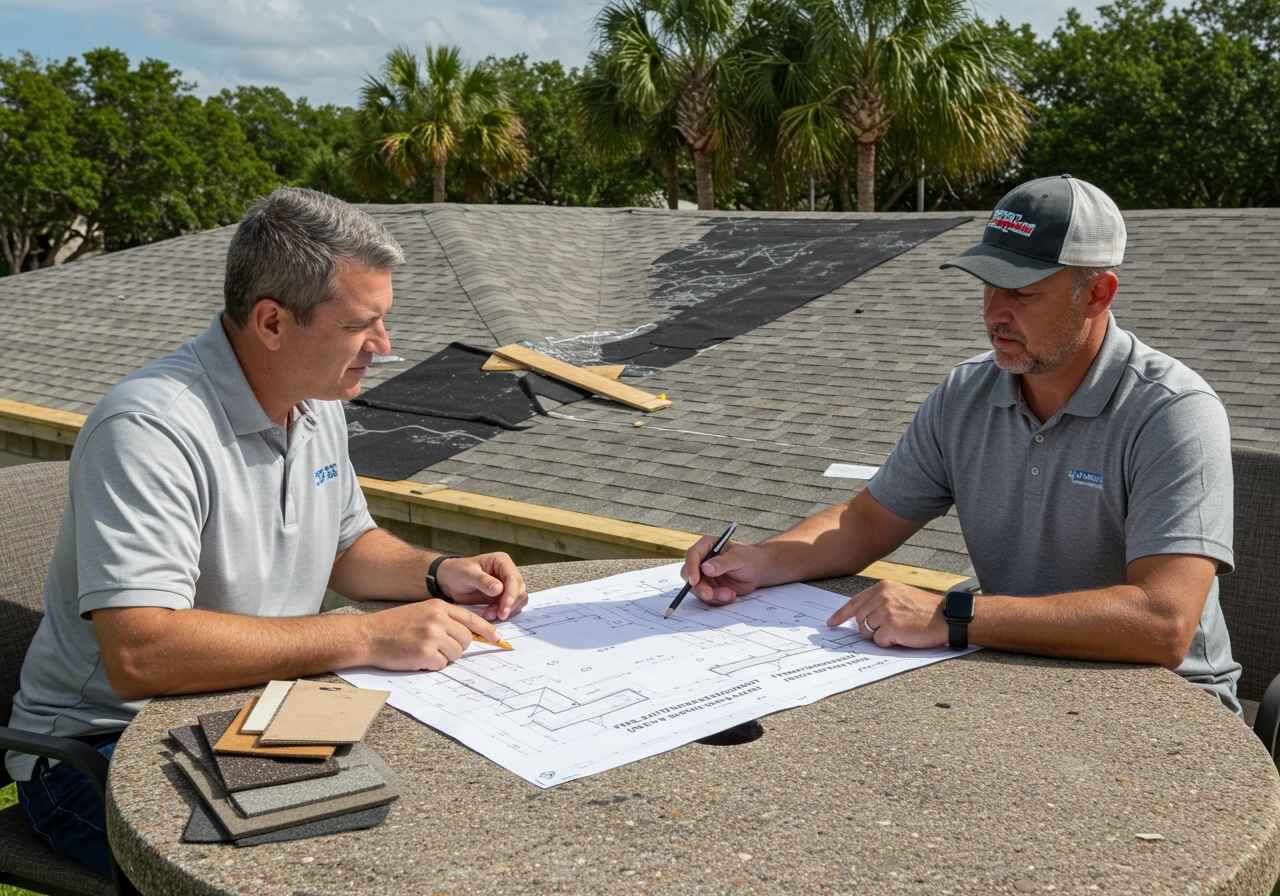
What to Ask Your Contractor About Fire-Rated Roofing
When it comes to fire-rated roofing systems, assumptions can be costly. Just because a material is labeled “durable” or “weather-resistant” doesn’t mean it meets fire-resistance standards—or local code requirements. That’s why asking the right questions before you sign a contract is critical.
Whether you’re managing a multi-family property, overseeing a commercial reroof, or upgrading a home in a wildfire-prone zone, here are key questions to bring to the conversation:
Smart Questions to Ask Your Contractor
- Is this underlayment Class A rated?
Make sure the underlayment contributes to a Class A roof system, which is the highest fire-resistance rating. Ask for documentation that shows compliance with fire testing standards like ASTM E108 or UL 790. - Will this underlayment meet my local building code?
Codes vary significantly by location. In fire-prone areas—like WUI zones or certain counties in Florida and California—fire resistant roof underlayment may be mandatory. Your contractor should be familiar with these requirements and how to meet them. - Does this product suit my roof type and slope?
Fire-rated underlayments differ in performance based on slope, material compatibility, and structural design. For example, self-adhering membranes might be ideal for low-slope commercial roofs, while synthetic options work better on steep residential ones. - What happens during inspection?
A good contractor will explain how fire-resistance is verified during code inspections and what steps they take to ensure the system passes. Ask if the product is recognized by local code enforcement and whether it has been used successfully in similar projects. - Will this affect my insurance or warranty coverage?
Non-compliant installations can result in denied insurance claims or voided warranties. Be sure the materials and methods used protect your long-term investment—both from a legal and financial standpoint. A roof safety assessment can help identify risks early.
Choosing the Right Partner
A knowledgeable contractor won’t just answer these questions—they’ll raise them before you do. At RayPro, for example, fire zone compliance and underlayment specifications are baked into every project plan. Our team ensures all materials meet relevant codes and are suited for your roof’s structure, use, and location.
Takeaway: The right questions now can prevent costly code violations and safety risks later. Work with a contractor who prioritizes fire safety, understands local regulations, and uses tested, certified materials from day one.
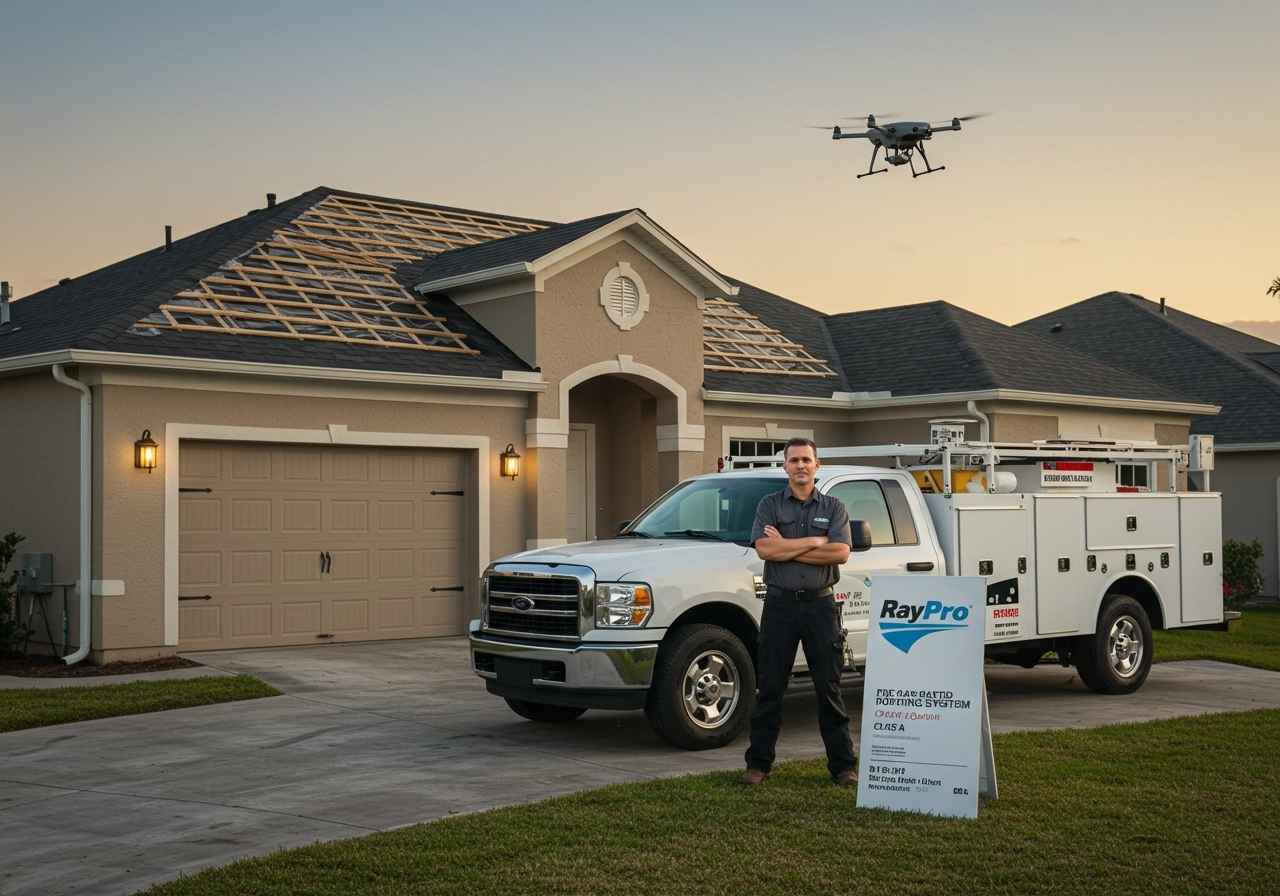
Conclusion: Protect Your Property and Stay Compliant
Fire-rated roof underlayment isn’t just a technical detail—it’s a key safeguard for your building’s safety, code compliance, and long-term performance. Whether you’re overseeing a residential roof replacement or a commercial retrofit, the right underlayment can make the difference between passing inspection and facing costly delays—or worse, being unprotected in a fire-prone area.
From meeting Class A roof system standards to satisfying local code requirements in wildfire-prone zones, fire-rated materials play a critical role in both risk reduction and legal responsibility. They help protect lives, preserve property, and support insurance eligibility, all while reinforcing the structural integrity of your roof.
As fire regulations tighten across the country—particularly in Wildland-Urban Interface (WUI) zones and high-growth regions like Florida and California—staying ahead of the code curve isn’t optional. It’s essential.
If you’re planning a roofing project, make it a priority to understand your local requirements and verify that all components, including underlayment, are properly rated and installed. That means working with a contractor who doesn’t just meet the code, but knows how to anticipate and exceed it. If you’re ready to get started, contact us for expert guidance and code-compliant solutions.
Takeaway: Fire-rated roof underlayment is an investment in protection, performance, and peace of mind. Partnering with a knowledgeable, code-savvy contractor is the smartest way to ensure your roofing system is as compliant as it is resilient.
Frequently Asked Questions
It depends on your location and local building codes. In many fire-prone areas—such as Wildland-Urban Interface (WUI) zones or certain Florida counties—fire-rated underlayment is required under tile or metal roofs to achieve a Class A fire rating. These materials alone may not offer sufficient fire protection without a compliant underlayment layer beneath them.
A Class A roofing system offers the highest level of fire resistance. It must pass tests for flame spread, ignition resistance, and burn-through performance. Underlayment is a critical part of the system; even if the surface material is fire-resistant, the system won’t qualify as Class A without a tested, fire-rated underlayment in place.
Some are, but not all. Fire-rated synthetic underlayments are specifically designed and tested to meet fire-resistance standards like ASTM E108 or UL 790. Always verify the product’s rating before assuming it qualifies for use in fire-rated systems.
Yes, in many cases. Florida has regions where fire-rated systems are recommended or required—especially in inland or forest-adjacent areas. WUI zones, common in states like California, Colorado, and parts of the Southeast, often mandate fire-rated underlayment under certain roofing types for both new builds and retrofits.
These are standardized fire tests used to evaluate roofing systems. A product or system must pass these tests to be classified as fire-rated (Class A, B, or C). Building inspectors and code officials rely on these certifications to determine whether your roofing assembly complies with fire safety regulations.
